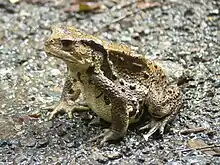| Japanese stream toad | |
|---|---|
 | |
| Scientific classification | |
| Domain: | Eukaryota |
| Kingdom: | Animalia |
| Phylum: | Chordata |
| Class: | Amphibia |
| Order: | Anura |
| Family: | Bufonidae |
| Genus: | Bufo |
| Species: | |
| Subspecies: | B. p. torrenticola |
| Trinomial name | |
| Bufo praetextatus torrenticola Matsui, 1976 | |
The Japanese stream toad (Bufo praetextatus torrenticola), also known as the Honshū toad, is a subspecies of toad in the family Bufonidae. It was first described by Masafumi Matsui in 1976 during research with Kyoto University as a "moderate to large-sized toad" with a "peculiar color pattern" and "stream-dwelling habits."[2]
It is endemic to Japan. Its natural habitats are temperate forests and rivers, mainly in the mountainous regions of Japan. It is threatened by habitat loss.[3]
Reproduction
Studies in rivers throughout the Toyama Bay region of Honshu, the main island of Japan, showed interbreeding between Bufo torrenticola and Bufo praetextatus formosus.[4]
It is believed that the Japanese stream toad is the only type of toad in Japan that spawns in streams rather than lentic habitats.[5] In these stream habitats, pools were the preferred site for spawning when compared with riffles and puddles.[5] In this same study, which was conducted over two years, it was noted that the same specific pools were used for spawning both years, suggesting site recognition by chemical or physical cues or possibly more complex requirements for viable breeding sites that need further study.
One theory presented as to how these subspecies were able to hybridize despite having different breeding sites was that flooding in the region had caused an overlap in lentic puddles and stream pools.[4] Spawning at the same time and at the same sites allows for introgression between the species.[4]
Morphology
As a result of being the only stream spawning member of the family Bufonidae in Japan, it has morphological characteristics that distinguish it from other species, and also Bufo praetextatus formosus.[6] The main adaptive characteristics noted have been long toe phalanges, more streamlined skulls, and large foot webs that make Bufo praetextatus torrenticola better suited to life in torrential waters.[6] Early descriptions of Bufo praetextatus torrenticola by Masafumi Matsui note that it lacks cranial crests, has limbs generally longer than Bufo bufo, and has a reduced tympanum.[2]
Conservation
The Japanese stream toad has been demoted to a taxon of least concern by the IUCN.[3]
References
- ↑ IUCN SSC Amphibian Specialist Group (2021). "Bufo torrenticola". IUCN Red List of Threatened Species. 2021: e.T54781A177177611. doi:10.2305/IUCN.UK.2021-1.RLTS.T54781A177177611.en. Retrieved 16 November 2021.
- 1 2 Matsui, Masafumi (1976). "A new Toad from Japan" (PDF).
- 1 2 Ssc), IUCN SSC Amphibian Specialist Group (IUCN (2020-07-09). "IUCN Red List of Threatened Species: Bufo japonicus". IUCN Red List of Threatened Species. Retrieved 2021-05-14.
- 1 2 3 Yamazaki, Yuji; Kouketsu, Saori; Fukuda, Tamotsu; Araki, Yoshimasa; Nambu, Hisao (September 2008). "Natural Hybridization and Directional Introgression of Two Species of Japanese Toads Bufo japonicus formosus and Bufo torrenticola (Anura: Bufonidae) Resulting from Changes in Their Spawning Habitat". Journal of Herpetology. 42 (3): 427–436. doi:10.1670/07-186.1. ISSN 0022-1511.
- 1 2 Tsuji, Hiroshi; Kawamichi, Takeo (1996). "Breeding Habitats of a Stream-Breeding Toad, Bufo torrenticola, in an Asian Mountain Torrent". Journal of Herpetology. 30 (3): 451–454. doi:10.2307/1565194. ISSN 0022-1511. JSTOR 1565194.
- 1 2 Tokita, Masayoshi; Hasegawa, Yuya; Yano, Wataru; Tsuji, Hiroshi (January 2018). "Characterization of the Adaptive Morphology of Japanese Stream Toad (Bufo torrenticola) Using Geometric Morphometrics". Zoological Science. 35 (1): 99–108. doi:10.2108/zs170099. ISSN 0289-0003.
